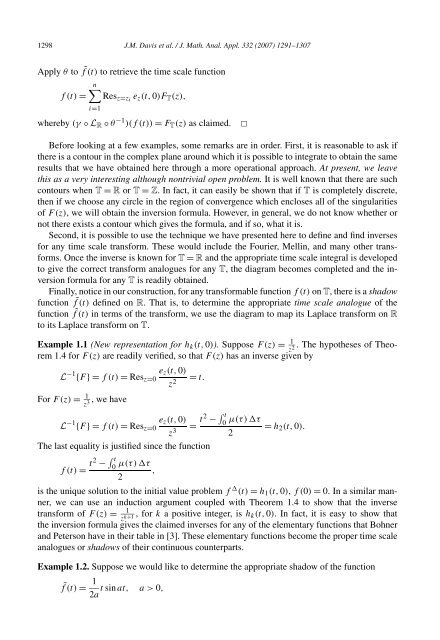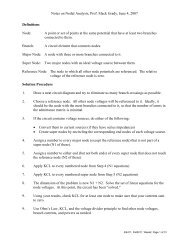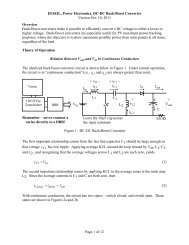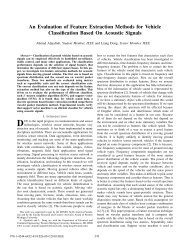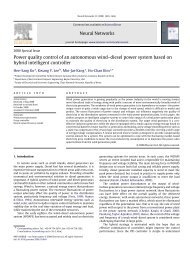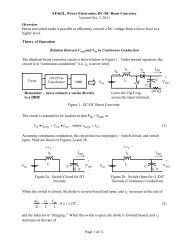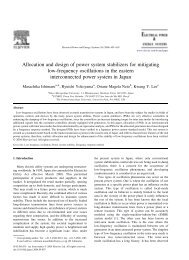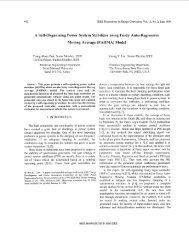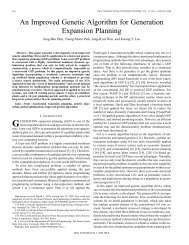The Laplace transform on time scales revisited - ECS - Baylor ...
The Laplace transform on time scales revisited - ECS - Baylor ...
The Laplace transform on time scales revisited - ECS - Baylor ...
Create successful ePaper yourself
Turn your PDF publications into a flip-book with our unique Google optimized e-Paper software.
1298 J.M. Davis et al. / J. Math. Anal. Appl. 332 (2007) 1291–1307Apply θ to f(t)to ˜ retrieve the <strong>time</strong> scale functi<strong>on</strong>n∑f(t)= Res z=zi e z (t, 0)F T (z),i=1whereby (γ ◦ L R ◦ θ −1 )(f (t)) = F T (z) as claimed.✷Before looking at a few examples, some remarks are in order. First, it is reas<strong>on</strong>able to ask ifthere is a c<strong>on</strong>tour in the complex plane around which it is possible to integrate to obtain the sameresults that we have obtained here through a more operati<strong>on</strong>al approach. At present, we leavethis as a very interesting although n<strong>on</strong>trivial open problem. It is well known that there are suchc<strong>on</strong>tours when T = R or T = Z. In fact, it can easily be shown that if T is completely discrete,then if we choose any circle in the regi<strong>on</strong> of c<strong>on</strong>vergence which encloses all of the singularitiesof F(z), we will obtain the inversi<strong>on</strong> formula. However, in general, we do not know whether ornot there exists a c<strong>on</strong>tour which gives the formula, and if so, what it is.Sec<strong>on</strong>d, it is possible to use the technique we have presented here to define and find inversesfor any <strong>time</strong> scale <str<strong>on</strong>g>transform</str<strong>on</strong>g>. <str<strong>on</strong>g>The</str<strong>on</strong>g>se would include the Fourier, Mellin, and many other <str<strong>on</strong>g>transform</str<strong>on</strong>g>s.Once the inverse is known for T = R and the appropriate <strong>time</strong> scale integral is developedto give the correct <str<strong>on</strong>g>transform</str<strong>on</strong>g> analogues for any T, the diagram becomes completed and the inversi<strong>on</strong>formula for any T is readily obtained.Finally, notice in our c<strong>on</strong>structi<strong>on</strong>, for any <str<strong>on</strong>g>transform</str<strong>on</strong>g>able functi<strong>on</strong> f(t)<strong>on</strong> T, there is a shadowfuncti<strong>on</strong> f(t) ˜ defined <strong>on</strong> R. That is, to determine the appropriate <strong>time</strong> scale analogue of thefuncti<strong>on</strong> f(t) ˜ in terms of the <str<strong>on</strong>g>transform</str<strong>on</strong>g>, we use the diagram to map its <str<strong>on</strong>g>Laplace</str<strong>on</strong>g> <str<strong>on</strong>g>transform</str<strong>on</strong>g> <strong>on</strong> Rto its <str<strong>on</strong>g>Laplace</str<strong>on</strong>g> <str<strong>on</strong>g>transform</str<strong>on</strong>g> <strong>on</strong> T.Example 1.1 (New representati<strong>on</strong> for h k (t, 0)). Suppose F(z)= 1 . <str<strong>on</strong>g>The</str<strong>on</strong>g> hypotheses of <str<strong>on</strong>g>The</str<strong>on</strong>g>orem1.4 for F(z)are readily verified, so that F(z)has an inverse given 2 byzL −1 e z (t, 0){F }=f(t)= Res z=0z 2 = t.For F(z)= 1 ,wehavez 3L −1 e z (t, 0){F }=f(t)= Res z=0z 3 = t2 − ∫ t0μ(τ) τ= h 2 (t, 0).2<str<strong>on</strong>g>The</str<strong>on</strong>g> last equality is justified since the functi<strong>on</strong>f(t)= t2 − ∫ t0μ(τ) τ,2is the unique soluti<strong>on</strong> to the initial value problem f (t) = h 1 (t, 0), f(0) = 0. In a similar manner,we can use an inducti<strong>on</strong> argument coupled with <str<strong>on</strong>g>The</str<strong>on</strong>g>orem 1.4 to show that the inverse<str<strong>on</strong>g>transform</str<strong>on</strong>g> of F(z) = 1 ,fork a positive integer, is hz k+1 k (t, 0). In fact, it is easy to show thatthe inversi<strong>on</strong> formula gives the claimed inverses for any of the elementary functi<strong>on</strong>s that Bohnerand Peters<strong>on</strong> have in their table in [3]. <str<strong>on</strong>g>The</str<strong>on</strong>g>se elementary functi<strong>on</strong>s become the proper <strong>time</strong> scaleanalogues or shadows of their c<strong>on</strong>tinuous counterparts.Example 1.2. Suppose we would like to determine the appropriate shadow of the functi<strong>on</strong>f(t)= ˜1 t sin at, a > 0,2a


